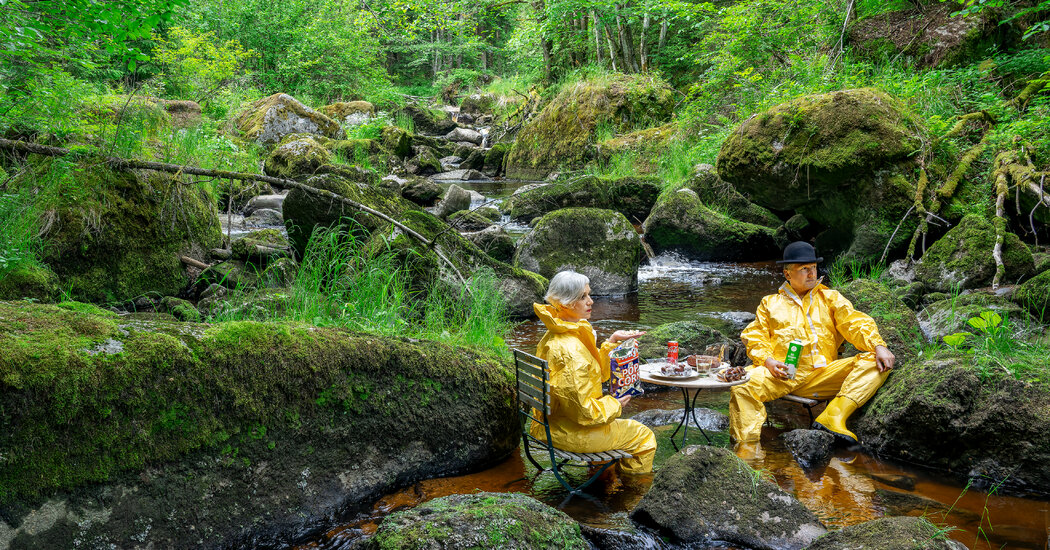This article is part of our Design special section about how food inspires designers to make and do surprising things.
Sonja Stummerer and Martin Hablesreiter have posed nude for photographs while sprawled amid spilled groceries. Garbed in evening wear or surgical scrubs, they have dragged shopping carts through pastures, dug appetizers out of topsoil and draped cucumber peels across their faces. While stomping vegetables underfoot at a barn, they have nibbled on Wiener schnitzel and nodded at each other across the table, in deadpan agreement that everything in the absurd scene tasted good.
Married artists and researchers based in Vienna, Ms. Stummerer and Mr. Hablesreiter run a company called honey & bunny. (It was founded two decades ago, without designating anyone a honey or a bunny.) Through performances, installations, lectures, workshops, films, photos and publications, they stir up questions about the rules and infrastructure that govern what we eat and how — and how our appetites can damage or benefit our bodies and the planet.
A recurring question in their work: “Is playing with your food actually immoral?”
From Cape Town to Brooklyn, they have dissected sandwiches with scalpels and handed out pickled vegetables as gaming pieces for rounds of bingo. Last week, a show of photos and videos of their recent mealtime experiments opened at the Austrian Cultural Forum in Rome (on view through July 18). And they are planning coming events, in Sweden, Germany and as far afield as China, that may call for descending into trenches to feast on edible soil.
During a series of video interviews, Ms. Stummerer described honey & bunny as always “open to being inspired,” even during everyday strolls through Viennese market stalls. When an idea springs to mind for adapting foodstuffs into educational public spectacles, one spouse is apt to turn to the other and say, in effect, “Isn’t that crazy? We could do that.”
The couple live and work in a 1910s apartment house on a quiet side street in northwest Vienna, adjoining hospital complexes. (The boxy cream-colored building’s other claim to fame is that belle époque clients of the artist Egon Schiele lived there.) They have crammed their storage crannies with props and costumes, including medical gear supplied by workers at nearby hospitals.
Ms. Stummerer, 52, is a chemist’s daughter and Vienna native. Mr. Hablesreiter, 51, is a cabinetmaker’s son from a small town in northern Austria, at the outskirts of the heavily armed Iron Curtain border with what was then Czechoslovakia. (He grew up vividly aware of the perils and privations faced by Czechoslovaks under communism.) Austria was “very un-Western” and culinarily provincial during their childhoods, Ms. Stummerer said. Their families cooked traditional meals, heavy on doughy dumplings, dairy products, pork and potatoes. Spaghetti Bolognese was an exotic occasional treat.
The pair met in the 1990s while studying architecture at the University of Applied Arts Vienna. They practiced architecture for a few years, with employers including Arata Isozaki in Tokyo, before realizing that they could support themselves by teaching, writing and experimenting in the emerging field of food design. These days, Ms. Stummerer said, “We earn about the same as before, but we have much more fun.”
One of the few drawbacks of their career shift was some scorn from architect colleagues, who deemed food studies a second-class pursuit. Mr. Hablesreiter said that a typical reaction was, “Ah, you’re doing a cookbook.”
The many rewards over the years have included the priceless reactions from their audiences. When honey & bunny, for instance, researched housekeeping practices by knocking on dozens of Austrian villagers’ doors and offering to clean rooms and conduct interviews, the homeowners were surprised but grateful and cooperative. “They told us about their worries and their sorrows,” Mr. Hablesreiter said.
The couple have collaborated with scholars in many related fields, including nutritionists and biologists. Honey & bunny’s doses of levity have come as a welcome relief from battles against misinformation about climate change and from studies of the devastating environmental impact of industrial food processing.
Honey & bunny are “always very playful,” said Fabio Parasecoli, a professor of food studies at New York University. “They never take themselves too seriously.”
Gabriel Roland, the director of Vienna Design Week, said that when anyone brainstorms with honey & bunny, “you really don’t know where it’s going to end up.”
“You have to be on the tips of your toes,” he said. There is a zone in the design realm where creativity meets context and boundaries, he added, and the two provocateurs “inhabit that with mischievous freedom.”
No notable professional mishaps have befallen honey & bunny, even as they have burned beetroot with a torch, slammed a steak against the wall of a building designed by Zaha Hadid, and banqueted in farmyards, rivers, laboratories, museum galleries and an elevator. They have felt only slightly uncomfortable while dining or roaming supermarkets while wrapped in clear plastic or black latex.
Ms. Stummerer only pretended to chop up and eat her own hand; it was a gilded chocolate prosthetic. Mr. Hablesreiter has not minded posing for cameras while his wife or strangers painted his belly with outlines of his digestive system, smeared him with dirt, stepped over his shirtless body prone on a kitchen floor, and fed him while he was blindfolded by a paper bag.
Not even leftovers have been harmed in the course of their career. They have given away food from their performances or eaten it themselves, “Everything that wasn’t completely destroyed,” Ms. Stummerer said.
The couple are still compiling lists of other sites where they would like to stage memorable meals, “someplace with no association with food, where people would never expect it,” Ms. Stummerer said.
Why not, perhaps, the Brooklyn Bridge? After all, to get anything done in this world, she said, “you should always be dreaming.”











